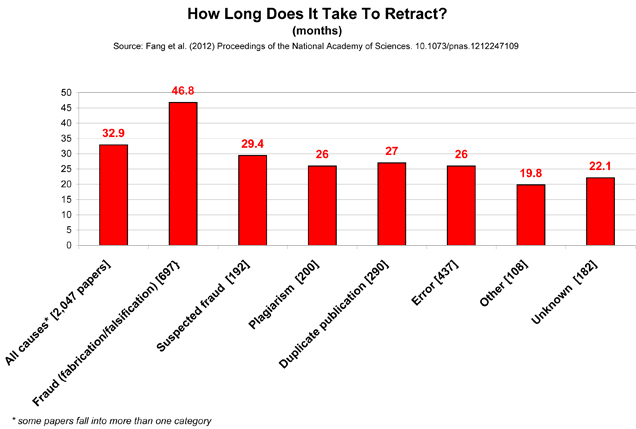
Casadevall and Fang, who are fascinated by scientific integrity in publication, wanted to follow up on work published last year. Medical writer R. Grant Steen had reported in the Journal of Medical Ethics that 73.5% of 742 papers retracted between 2000 and 2010 were pulled because of errors. "What I was interested in was to see if we could understand the sources of error," says Casadevall, who runs a lab at Albert Einstein College of Medicine in the Bronx, New York, and is editor-in-chief of mBio. That way, he and Fang thought, "we may find a way to improve science" by giving researchers a heads up about where the most common pitfalls lie.
They asked Steen to join them, and together searched PubMed for all retractions, coming up with a total of 2047 dating back to 1977. (PubMed primarily covers biomedical research.) Rather than rely just on retraction notices from journals -- which in some cases they couldn't access without paying a fee, Casadevall says - they cross-referenced as many retractions as they could with other sources, including reports from the U.S. Office of Research Integrity (ORI), which investigates scientific misconduct.
As it turned out, the wording in retraction notices, which are generally written by authors, was often misleading. In a supplementary table, the authors detail 158 retractions that they reclassified. For example, the retraction notice for a 2005 paper in The Journal of Cell Biology said that "follow-up experiments ... have shown that ... Figure 1 is not correct." As it turned out, ORI had investigated the case and concluded that the first author had "knowingly and intentionally falsified data."
In all, about 67% of the more than 2000 papers were retracted because of misconduct, which included fraud and plagiarism. Just over one-fifth were retracted because of mistakes, and the rest were pulled for unknown or other reasons.
Science has the dubious distinction of being ranked first for the number of articles retracted, 70, just edging out PNAS, which comes second with 69. Thirty-two of Science's retractions were due to fraud or suspected fraud, and 37 to error. These days, "the value of the work is determined by where it is published," Casadevall says. Last year, he and Fang devised a "retraction index" to show that journals with relatively high impact factors, such as Science, Nature, and Cell, had a higher rate of retractions.
Although retractions are on the rise, they remain relatively rare in science. Well under 0.1% of papers in PubMed have been retracted, the study found; the database contains more than 25 million papers going back to the 1940s.



"In all, about 67% of the more than 2000 papers were retracted because of misconduct, which included fraud and plagiarism."
If that is a "true" measure and is could be applied +/- to the 25 million papers since 1949, there is one heck of a lot of junk science out their driving the bus.